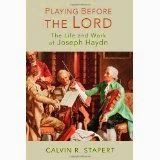Playing Before the Lord, The Life and Work of Joseph Haydn by Calvin R. Stapert and published by Eerdmans, www.eerdmans.com is a treasure for both the professional musician and the ordinary person who knows a little about music from lessons learned earlier, and maybe from trying a bit of composing and writing poetry, but always eager to learn more. Stapert is professor emeritus of music at Calvin College in Michigan and he is more than qualified to teach and share his knowledge of music and Haydn.
Franz Joseph Haydn was baptized on April 1, 1732, perhaps born on March 31, 1732 (d.. 1809), in a village near the Austrian-Hungarian border. At age six, he was sent to live with the Franck family in a nearby town, where he would begin school. He was instructed in “reading, writing, catechism, singing, and almost all wind and string instruments, even in timpani.” Haydn said, “I shall owe it all to this man (Franck) even in my grave.” Haydn obviously had talent in music and soon (1740s) was sent to Vienna to be a choir boy.
Using dates and decades as subheads, Stapert follows Haydn from choir boy to freelance musician; music director in the 1750s; Vice-Kapellmeister and Kapellmeister at the Esterhazy Court in the town of Eisenstadt, Austria in 1761, where he describes himself as “composing, directs all music, helps rehearse everything, gives lessons, even tunes his own clavier.” Stapert analyzes how Haydn puts together the musical notes and phrases; how he plans for each instrument to join in at the appropriate moment, adding “solos integral to the whole.” He describes Haydn as a composer “with an unerring sense of musical form and an uncommon ability to recognize the developmental potential in simple musical materials.” And with diagrams and examples of notes on scales, Stapert shows the reader how Haydn did it.
Stapert loves Haydn and his “huge and diverse output” of music, and Stapert’s book is biography, as well as a listener’s guide. At the end, there is an appendix outlining Haydn’s famous oratorio called The Creation; a glossary of technical terms; an impressive list of Haydn’s works, which include concertos, keyboard sonatas and trios, masses, operas, songs, string quartets, opus, symphonies, and more.
Haydn stayed with the Esterhazy Court for much of his adult life with trips back and forth to Paris, London, and Vienna, where he also composed, performed, and saw publishers and friends. He counted Mozart and Beethoven among his friends, lucky three! Haydn saw his musical talent as a gift from God, and Stapert says that Haydn “often penned at the end of his scores: Laus Deo! – Praise to God!” Besides The Creation, Haydn is famous for Stabat Mater, in honor of the Virgin Mary, still popular in music of the church year; and his symphonies called The Seasons, and Surprise. He is also known as composer of the tune for John Newton’s hymn, “Glorious Things of Thee Are Spoken”(1779). Stapert would like to see Haydn’s work become popular again and it may happen. Stapert’s book is an excellent way to learn more about Haydn and his music. May it encourage musicians and other readers to “play it again.......”
—Lois Sibley

No comments:
Post a Comment